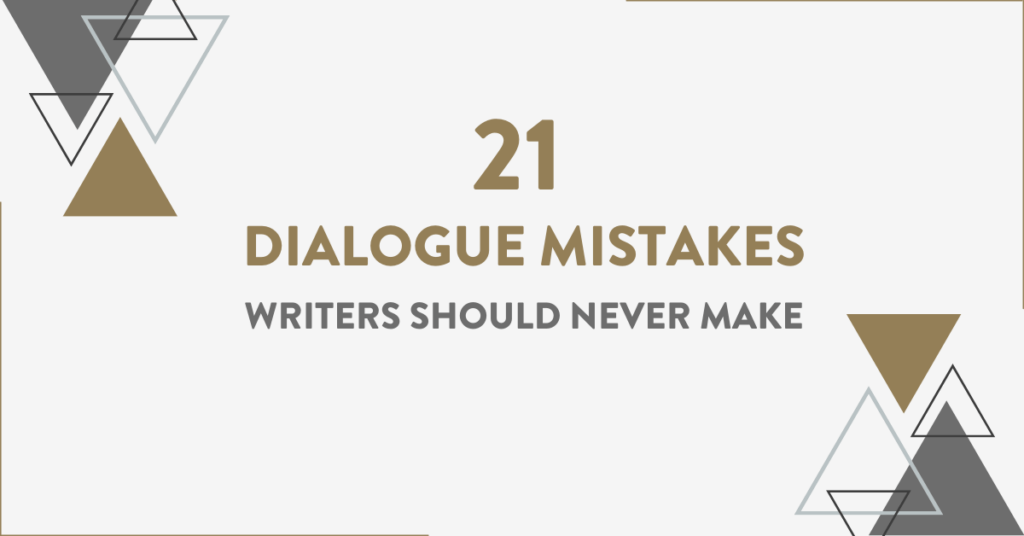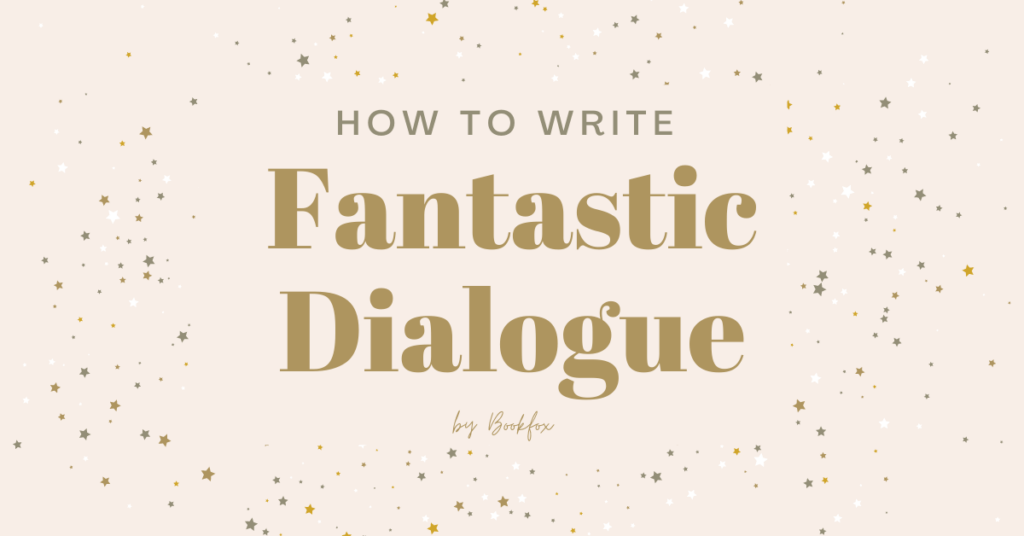
Nothing can ruin a book faster than bad dialogue. It makes readers roll their eyes and give up on your book.
Fantastic dialogue, on the other hand, reveals character, gives us a sense of place, provides tension and emotion, and helps move the plot forward.
To help you out with writing dialogue, I’m going to give you the 21 mistakes I see writers make most frequently. And these aren’t pulled out of a hat — they are very common mistakes I see all the time.
1. Sounds Too Everyday
Everyday conversations are not the most riveting. Many consists of stubborn filler words (“um,” “you know,” “I mean” and the dreaded “like”) and repetition to get a point across.
Everyday conversation can also consist of small talk about things no one really cares about, including the weather. Writing dialogue that sounds too like a thousand everyday conversations will only bore readers.
“I hear it’s supposed to rain tomorrow,” Cheryl said.
“You know, I heard that too,” Frank said.
“Um, do you think we should pack an umbrella?” Cheryl said.
“I mean, if it says rain is in the forecast I think we should,” Frank said.
The conversation above might sound like a real conversation but it isn’t fun to read. It sounds too mundane and the filler words make it clunky. Make sure the conversation is there to help move the story along rather than keep it stuck on the forecast.
2. Uses Author’s Voice

When your dialogue sounds more like you, the author, rather than your character, the reader can tell.
This type of dialogue makes it too “on the nose” for the reader without allowing them to uncover the character’s intentions on their own.
For example, a character telling someone how they feel (“I’m so angry with you”) is not as exciting as showing how this character feels. Someone who is angry with another might show this by cutting the other person off when they are speaking or only answering in one-word sentences.
Let the true voice of your characters shine in dialogue to reveal their intentions more naturally.
3. Characters Sound the Same
No one wants to read a book where all the characters sound the same. A conversation where everyone has similar speech patterns and vocabulary, without any real change in tone or pronunciation, is not exciting.
“I told you I was mad at you,” she said.
“I still don’t understand why,” he said.
Both characters above have a similar monotone voice without any real emotion behind what they are saying. Show off the unique personality of each character with a distinctive voice for each, keeping the conversation interesting and making it easy for the reader to differentiate between who is who.
For more examples of how to distinguish between characters, look at my post 50 Examples of Great Dialogue.
4. Unnecessary Monologues

Characters have a lot to say but that doesn’t mean they should go on and on without any interruption. Dialogue from a character that continues for a page or more is too dense for a reader to stay invested.
“I for one, am not excited about this trip. I don’t want to see Danny there with some other woman on his arm. How am I supposed to deal with that? Why didn’t anyone take my feelings into consideration when they booked this trip? I am a recently single forty-year-old woman with no new prospects. How am I supposed to feel better about myself when Danny is there with someone new and I am there all alone? Yes, I know, I have you there too, Amy, but come on. It’s not the same thing and you know it. I am all alone. I will always be alone. Oh please, don’t give me that look. You know I will die alone…”
The above isn’t terribly long but it’s long enough and if it continues for a page and a half, you may lose your reader with this character’s rambling.
Monologues work for plays but not so much in novels. The same goes for internal monologues. Too much internalizing is a major buzzkill. Monologues of any kind should be broken up with action and conversation.
5. Dialogue Without Tension
A conversation without any tension goes nowhere and is pretty meaningless to your story. This type of dialogue is also dull to read. Case in point:
“That’s a nice chair,” Dave said.
“Thanks,” Laura said.
“Is it new?”
“No. I bought it years ago.”
No one cares about how nice the chair is unless there is meaning behind it. It would be different if Dave was eyeing the chair with intent to use it as a weapon on Laura.
That would cause tension and help move the story forward, which is what good dialogue should do.
6. Dialogue Without Action
When people talk in a conversation they aren’t usually just standing still. They are fidgeting or crossing their arms, maybe touching their chin or brushing their hair away from their face.
Characters shouldn’t talk without any movement either. It’s not natural and it’s not interesting.
“Nice to see you,” Alex said.
“Same to you,” Gina said.
“You look good, Alex said.
“So do you,” Gina said.
It’s clear Alex and Gina haven’t seen each other in a while but there are no actions to show how they really feel about this interaction. Are they anxious? Happy? We don’t know because their body language isn’t telling us anything.
When you add movement and action to the conversation you’re able to show emotion and interaction with your characters so they come alive and are relatable.
7. No Stakes
Stakes in a story not only help create tension but also help build the character. Without stakes we don’t know what the character wants or is trying to achieve, therefore, we may not truly understand their actions or the point of the story.
“What are you doing here?” the woman said.
“I don’t know,” the man said.
“But why have you come now?”
“I’m not really sure.”
The man in the above conversation must have gone to see the woman for some reason, although he is not being clear why. While the woman in the story may not need to know why the man came to visit, the reader should understand his intentions.
When the stakes are clear, we’re able to connect with the character and possibly root for them to get what they want.
Remember: practicing dialogue will help you improve the most.
If you’d like some exercises in how to write dialogue, please check out 30 Dialogue Exercises.
8. Too Much Dialect

While it’s important to use dialect markers to help make your character unique, show off their personality and where they are from, it’s best not to overdo it.
“Better not think I’m feeding y’all,” she said.
“But everyone came for dinner, Grandma,” he said.
“Hold your horses now,” she said. “Y’all just better think about going out for supper.”
There are too many “y’alls” in the above conversation which gets repetitive and tiresome. Show off your character’s ethnicity with his or her dialogue but do so by using dialect markers moderately. Your reader will pick up on it without it being forced on them.
9. Expositional Dialogue
Yes, some background information on your character, setting, and plot is okay, but having too many risks the chance of losing your audience. No one wants to read all about the backstory. They want to see it unfold on the page.
Using dialogue to provide too much exposition has you telling the story rather than showing it in a scene.
“Beth is my best friend from childhood. She is tall and skinny with brown hair and never afraid to use her good looks to get what she wants. At prom, she had all the boys swooning over her with that blue dress she wore. She’s always been very flirtatious with everyone, and if she doesn’t like you, watch out.”
All of the above information could have been written in a scene and also used in conversation with another character rather than one person over-explaining.
Finding that sweet spot of just enough exposition to provide needed information while not boring the reader can be challenging but definitely not impossible. Find ways to weave background information throughout the story rather than dumping it in all at once.
10. Not Trusting Your Reader
When using dialogue to throw out too much information to the reader you are spelling everything out for them without trusting they will uncover it on their own.
A common example of this is when a character refers to something from the past to another character: “Claire, you remember the time we escaped the ward.”
Of course, Claire remembers that time, but the reader is not familiar. By explaining this incident (which appears to be a big once since it involves escaping from a ward), it cheapens the story. A reader wants to uncover the character’s secrets, relationships, and past on their own, not by being told about them by the author.
11. Using Fancy Dialogue Tags
Dialogue tags can be tricky. While they help to associate who is speaking, they can be a little redundant or unpleasant when used incorrectly. Here’s the thing to remember: dialogue tags are meant to blend in. You want the reader to focus on what is being said, not the dialogue tag itself.
“Amy, you are out of your mind if you think I am going to do that,” Sarah blurted out.
“But why not?” Amy inhaled.
When it comes to dialogue tags, it’s best to keep it simple. Stick with the traditional “said” rather than trying to be creative with tags like “exclaimed” or “expressed.”
12. Unspoken Dialogue
A reader can tell when a writer has never read their own dialogue out loud.
It sounds clunky. It sounds artificial. The reader won’t believe that any human being would ever say something like that.
Reading your work aloud helps you hear how it sounds rather than how you think it sounds in your head.
“I always thought I’d love you but when I saw you the other night after all this time I realized that I don’t feel the same way and I hope you don’t hate me and I hope you won’t think I never loved you before because I did.”
The above sentence is way too breathless and longwinded. When reading your dialogue aloud, check to see if there are pauses where there should be and that the lines are clean and direct.
13. Characters Never Interrupt
In real life, most people aren’t polite when it comes to their turn to talk.
Your characters should not be overly polite when talking either.
“I’m so glad we no longer have him as mayor,” she said. “He was horrendous.”
“He wasn’t that bad,” he said.
“Wasn’t that bad?” She said. “How could you say such a thing?”
“He seemed okay.”
“I don’t understand you at all.”
The above conversation would have been much more heated had it been in real life. There would likely be interruptions that included yelling and cutting one another off. Don’t be afraid to show your character’s true colors.
14. Never Using Silence

When writing dialogue don’t underestimate the power of silence.
While what someone says and how they say it is important, silence can be just as impactful in the right setting. When silence isn’t used when it should have been, it can keep an unnecessary conversation going or give away too much too soon.
“You never loved me,” she said.
“I did,” he said.
“But why would you have done what you did then?”
“I’m sorry.”
The line “I did” above is useless. It would be much better if the man said nothing in response, but did something instead.
Leaving things unsaid is a great way to approach complex emotions without making the conversation seem tawdry and artificial.
15. Using Unnecessary Dialogue
Often, we feel using dialogue may be better than summarizing because it helps build a scene. This is true, however, don’t use dialogue just to use it. Dialogue needs a purpose besides only being used to create a scene:
“Mom, do you remember the time we went to the beach when I was a kid? And I got sand in my eye?”
“I remember.”
“I always think of that when I go to the beach.”
The above exchange could have been summarized in a quick sentence while the character was at the beach, rubbing his or her eye. When dialogue doesn’t move the plot forward or offer any real insight within the characters, summarizing might work better — if you need that information at all.
16. Dialogue Trying Too Hard
As writers, we have a deep appreciation for the written language, hence why we do what we do. And while we appreciate narrative prose for its gorgeous literary and poetic lines, we have to be honest: most people do not talk that way in conversation.
“For I am only but a simple man, Maddie. I yearn for the snowcapped covered mountains on a cool winter’s day. The sky, clear from clouds, Robin’s egg shade of blue. I want to warm my hands but the fire which crackles in the corner of a warm chalet, don’t you?”
Be sure you’re not trying too hard to sound overly literary when writing dialogue for characters. Leave that for the narration in your novel and allow your literary skills to shine when describing a place or emotion, rather than in conversation.
17. Not Observing How Real People Talk
If you’re writing dialogue the way you think it should sound rather than using real observations, you’re going about this all wrong. You may be surprised at what you hear. For example, people don’t usually call one another by their first name when speaking:
“I thought we were best friends, Sarah” Sammie said.
“You were so very wrong, Sammie,” Sarah said.
Get inspired by sitting in a cafe and listening to how others talk to one another. Use a similar voice or mannerism from someone in your real life to draw inspiration for a character in your writing.
18. Reading the Wrong Books

You’re a writer so you already know how important reading is to your craft. However, if you’re not reading books that inspire the writing style you want to achieve, you aren’t reading the right books. If you’re writing adult literary fiction you probably don’t want to read And to Think That I Saw It on Mulberry Street by Dr. Seuss (unless you’re reading it to your child at bed):
“Stop telling such outlandish tales. Stop turning minnows into whales.”
Try reading from the greats, such as Toni Morrison and John Steinbeck to get inspired on how to write good dialogue. Be sure to also read the books in your genre to see how published authors have done it and use that as fuel for your own work.
19. Overboard on References and Slang
If you use the coolest phrases on the street, it’s going to make your writing seem dated in only a few years.
“That’s lit,” Maria said.
“Totally sick,” Abraham said.
“You the dopest,” Maria said.
“I know,” said Abraham. “Don’t be salty about it either.”
Too many modern references, such as the latest iPhone, tablet or cryptocurrency don’t work well either. If you want to keep your novel ageless so your reader can go back time and time again, it’s best to keep modern slang and references to a minimum.
20. Not Personalizing Dialogue
It’s good to write that dialogue that seems like it’s from a place: regional dialogue.
Omitting that makes characters seem thin and fake, because they don’t have the dialogue that matches their background.
For example, a woman from London may use the term “dapper” to describe a man who is smarty dressed, while a woman from America may say the man looks “handsome.”
You want to include some character mannerisms or idioms that help show who your characters are and where they are from. Just don’t overdo it.
21. No Change in Voice
In real life, no voice sounds the same in a given conversation. Dialogue in a story shouldn’t sound the same either.
Without any change in voice, there is no difference in volume, pitch, or speed which is unnatural. For example, a reader will not know that a conversation is heightened with tension or emotion without a change in the voice:
“I thought you said this was the last time we’d catch you stealing,” he said.
“I’m sorry, I didn’t mean to, it just happened?” she said.
“It just happened?” he said. “How did it just happen that you stole $10,000 from the company?”
“I couldn’t help it,” she said. “I really needed the money. I’m sorry.”
“You’re sorry?” he said. “That’s all you can say? You’re sorry?”
“Yes.”
The above conversation is lacking any change in voice from either character, making what could be a compelling scene not very exciting. Change in voice helps a reader understand that something may be going on with a character or in a scene that is not explained just yet, keeping them eager to turn the page to see what happens next.




3 comments
Thank you. I have been trying to write a book for a long time. It is so difficult to get good advice, most people want to sell you something, all the time. I started with a couple of blogs and I am trying to get a following. I like your advice, it is straight and useful, again, thank you.
What do you think of using the present tense “says” instead of the past tense “said” throughout the pages of dialog? When the discussion refers to something in the past then use past tense. My book is a novel.
If the book is in past tense, you should stick with “said.”